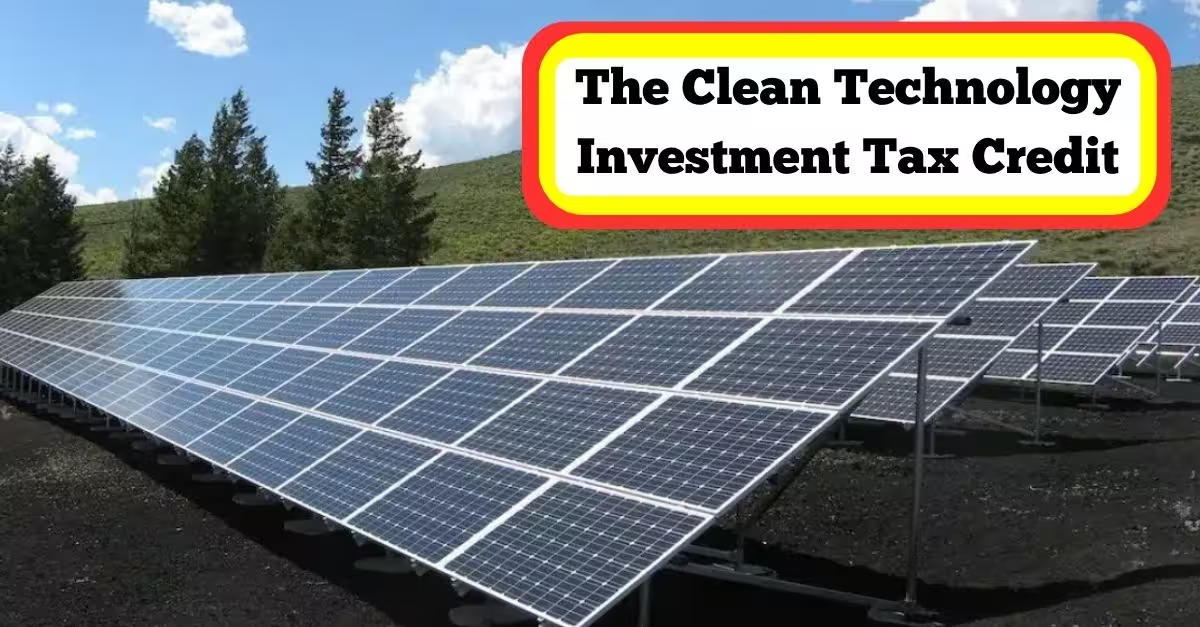Clean Technology Investment Tax Credit (CT ITC): The Clean Technology (CT) Investment Tax Credit (ITC) is a refundable tax credit offered by the Canadian government to incentivize investment in clean technology. It aims to foster innovation and adoption of clean technologies to reduce greenhouse gas emissions and support a sustainable economy. So if you are also engaged in clean technology investment programs in Canada then can file the text which is refundable through CT ITC 2024. Read this article to get all the information of the clean technology investment tax credit including the procedure to claim the credits, eligibility criteria, last date to apply, benefits etc.

Clean technology investment tax credit 2024
The Clean Technology (CT) Investment Tax Credit is a Canadian tax incentive program that encourages businesses to invest in clean technology by providing a tax credit of 10% to 50% of eligible expenditures. Eligible businesses operating in Canada can claim the credit against their federal income tax for investments in renewable energy systems, energy efficiency technologies, electric vehicle charging infrastructure, carbon capture and storage, and other technologies that reduce greenhouse gas emissions.
The credit can be carried back three years or carried forward 20 years and is claimed on the tax return using Form T661. This program aims to support the development and deployment of clean technologies, reduce emissions, and promote sustainable growth. The credit is available for capital invested in new clean technology property from March 28, 2023, to December 31, 2034.
Eligibility
- Taxable Canadian corporations (including those that are members of a partnership)
- Mutual fund trusts that are real estate investment trusts (including those that are members of a partnership)
- Employers who elect to meet the labour requirements can avoid claiming the reduced tax credit rate.
- You can claim both the CT ITC and the Atlantic investment tax credit.
- You can generally claim only one clean economy ITC for the same eligible property (e.g., cannot claim CT ITC if claiming CCUS ITC for the same property).
- You may claim multiple clean economy ITCs for the same project if the project includes different types of eligible property.
Property for claiming the credits
It is important for individuals who are applying for clean technology investment tax credit in Canada to invest in the following properties only otherwise they will face difficulties to claim the 100% credits.
- Equipment must be situated in and intended for use exclusively in Canada.
- Equipment must not have been previously used or acquired for use or lease before acquisition by the taxpayer.
- If leasing CT property to another person or partnership, additional requirements apply.
- Renewable Energy Equipment: This category includes equipment used to generate energy from solar, wind, and water sources. Solar energy generation equipment harnesses energy from the sun, while wind energy generation equipment uses wind turbines to produce electricity. Water energy generation equipment, such as hydroelectric power plants, leverages the energy of moving water to generate electricity.
- Energy Storage Equipment: These technologies store excess energy generated from renewable sources for later use, helping to stabilize the grid and ensure a reliable energy supply.
- Heating and Cooling Equipment: active solar heating equipment, air-source heat pumps, and ground-source heat pumps. Active solar heating equipment uses solar energy to provide space heating, while air-source and ground-source heat pumps utilize heat from the air and ground, respectively, to provide efficient heating and cooling.
- Zero-Emission Vehicles and Infrastructure: such as electric forklifts and airport ground support equipment, as well as related charging and refueling infrastructure. These technologies reduce greenhouse gas emissions and promote sustainable transportation.
- Geothermal Energy Equipment: This category includes equipment used exclusively for generating electrical or heat energy from geothermal energy, without extracting fossil fuels for sale. Geothermal energy harnesses heat from the Earth’s core to produce electricity or provide direct heating.
- Concentrated Solar Energy Equipment: This category includes equipment used for concentrated solar energy generation, which uses mirrors or lenses to focus sunlight and generate heat or electricity.
- Small Modular Nuclear Reactors: these are compact, scalable nuclear power plants designed for efficient and safe energy generation. These reactors offer a low-carbon energy solution with reduced waste production.
Procedure to claim the CT credits
To claim the Clean Technology (CT) Investment Tax Credit, corporations and trusts must file the claim on their tax returns. Corporations use Form T2SCH31 and claim the credit on line 155 of Schedule 31, while partnerships and trusts may be eligible for additional incentives and file with their T3 Trust Income Tax and Information Return.
The claim must be filed by the tax return due date, but late filing may be accepted up to one year later. When filing, provide a summary of the CT ITC claim and recapture, including total amounts, allocations from partnerships, and details on each CT property, such as CCA class, property type, cost, and province or territory. Attach the required documents to your return, and consult official government documentation or a tax professional if needed.